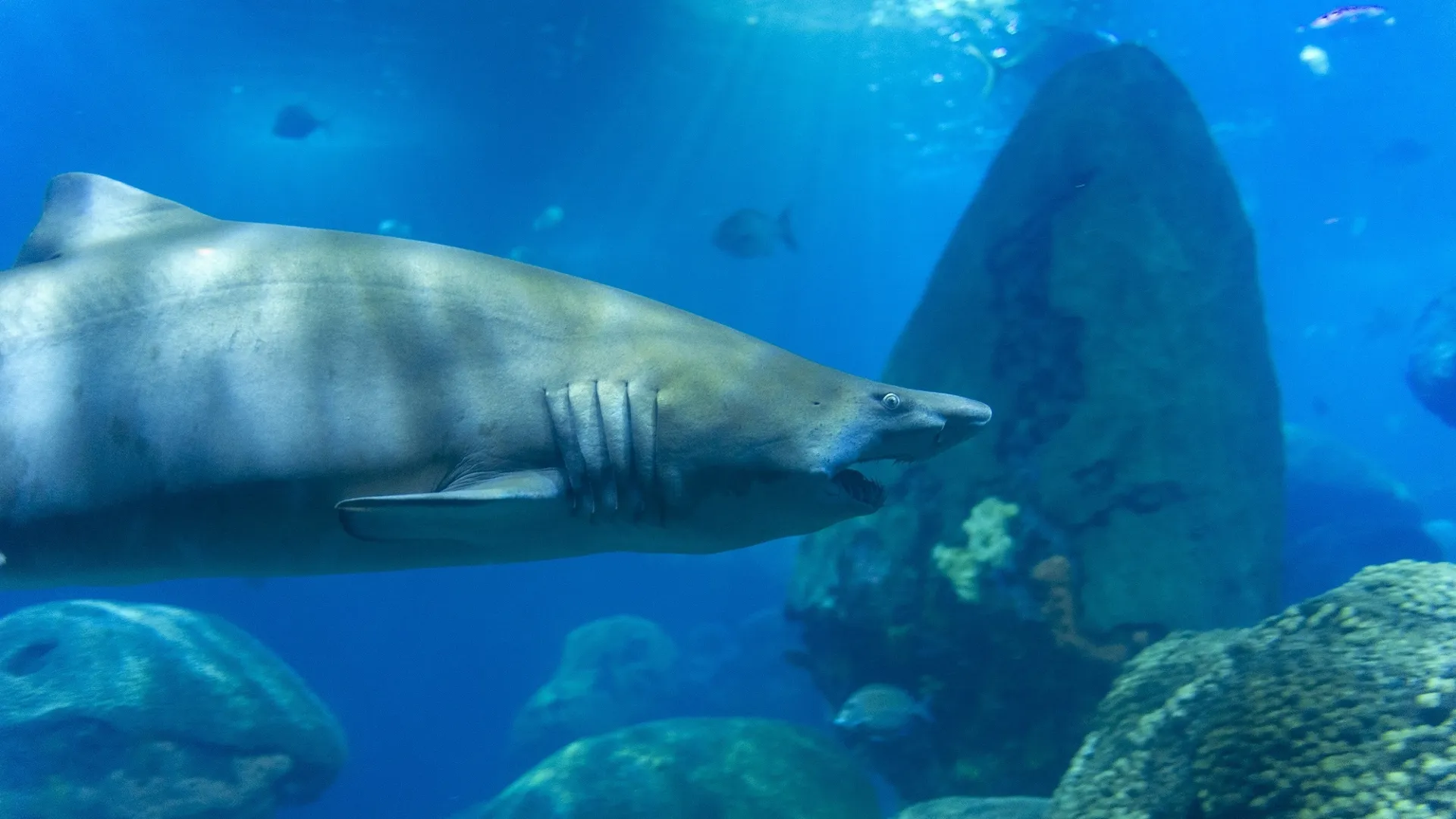From the hopping pirouettes of Sandhill Cranes and sway-necked waltzing of Ostriches to the thunderously complex arias of Humpback Whales, courtship in the natural world can literally be a performance art.
When it comes to some species’ romance, however, Pat Benatar was closer to the mark by describing love as a battlefield.
In recent weeks, the always-live web cam in the Tennessee Aquarium’s 618,000-gallon Secret Reef exhibit captured the rare sight of some seemingly scary behavior between a pair of Sand Tiger Sharks (also known as Grey Nurse Sharks).
The Secret Reef is home to three male Sand Tigers and a pair of females introduced in the fall of 2020 and 2021, respectively. At lengths of up to ten feet and with rows of needle-like teeth on prominent display through their partially agape jaws, Sand Tigers seem ferocious but are actually quiet docile … except when it comes to romance.
In the last days of January and early February, the Aquarium’s streaming camera recorded several instances of a female Sand Tiger receiving affection from a male in a display that gives new meaning to the term “love bites.”
Male Sand Tigers must fertilize the female’s eggs internally. In order to orient themselves and their partner for successful fertilization during mating, males turn to the one tool they have available to them: their teeth.
“If they’re facing the same direction, he’ll typically grab the female by the large fin that sticks out of her side and contort his body around her,” explains Thom Demas, the Aquarium’s director of aquatic collection and life support systems.
If the female isn’t facing the right direction or hasn’t acquiesced to the male’s advances, however, he will use this toothsome embrace to reorient her. These swirling, lock-jaw contortions look aggressive and often leave behind bite marks, but female Sand Tigers are well-equipped to withstand this affection.
“It appears pretty vicious, but that’s how these sharks reproduce,” Demas says. “They’re designed for this. Their skin is made of tough ‘scales’ called dermal denticles and can be much thicker than males. While they do get some injuries during mating, they’re usually superficial, and they heal.”
Sand Tiger Sharks are ovoviviparous, meaning fertilized eggs develop internally inside the female’s two uteri. If the Aquarium’s rarely-seen mating displays are successful, any fertilized eggs will develop internally for nine to 13 months before emerging.
“It looks like a live birth, but it’s more like an egg hatching and then they’re born,” Demas explains. “It’s a little different than mammals, but it looks similar to live birth.”
During internal development, the largest Sand Tiger embryo in each uterus will gain nourishment by consuming its smaller siblings, leading to a litter size of just two pups. This practice, also known as intrauterine cannibalism, means this species has one of the lowest reproductive rates of any shark.
This low birth rate is a particular problem for Sand Tigers, which were classified in 2020 as critically endangered despite being found in warm or temperate waters along the coastline of every continent except Antarctica.
It appears pretty vicious, but that’s how these sharks reproduce. They’re designed for this.
In the coming weeks, the Aquarium’s animal care specialists will be monitoring the exhibit for further signs of courtship or indications that mating was successful. If the female does pup, it would be a milestone moment for human care of Sand Tigers, Demas says.
“I’m not sure this would be the first Sand Tiger to reproduce in human care, but it would be one of very few ever, and I don’t know of any that have captured mating on video,” Demas says.
“The fact that this mating is happening unassisted by human intervention — just as a result of good care and diet and a healthy habitat — would be a good sign that reproduction in a well-designed habitat is attainable. That’s great for the species, since our goal is to be able to manage them in human care to help safeguard and offset their decline in the wild.”
To keep an eye on the unfolding romance between the Aquarium’s Sand Tiger Sharks, or just to catch up on the other residents of the Secret Reef, tune into the exhibit’s live webcam at tnaqua.org/live/secret-reef/
